List of ursids
Ursidae is a family of mammals in the order Carnivora, which includes the giant panda, brown bear, and polar bear, and many other extant and extinct mammals. A member of this family is called a bear or an ursid. They are widespread across the Americas and Eurasia. Bear habitats are generally forests, though some species can be found in grassland and savana regions, and the polar bear lives in arctic and aquatic habitats. Most bears are 1.2–2 m (4–7 ft) long, plus a 3–20 cm (1–8 in) tail, though the polar bear is 2.2–2.44 m (7–8 ft) long, and some subspecies of brown bear can be up to 2.8 m (9 ft). Weights range greatly from the sun bear, which can be as low as 35 kg (77 lb), to the polar bear, which can be as high as 726 kg (1,600 lb). Population sizes vary, with six species classified as vulnerable with populations as low as 500, while the brown bear has a population of over 100,000 and the American black bear around 800,000. Many bear species primarily eat specific foods, such as seals for the polar bear or termites and fruit for the sloth bear, but with the exception of the giant panda, which exclusively eats bamboo, ursids are omnivorous when necessary. No ursid species have been domesticated, though some bears have been trained for entertainment.[1]

The eight species of Ursidae are split into five genera in three subfamilies: the monotypic Ailuropodinae, the panda bears; Tremarctinae, the short-faced bears; and Ursinae, containing all other extant bears. Extinct species have also been placed into all three extant subfamilies, as well as four extinct ones: Agriotheriinae, Amphicynodontinae, Hemicyoninae, and Ursavinae. Over 100 extinct Ursidae species have been found, though due to ongoing research and discoveries the exact number and categorization is not fixed.
Conventions
| IUCN Red List categories | |
|---|---|
| Conservation status | |
| EX | Extinct (0 species) |
| EW | Extinct in the wild (0 species) |
| CR | Critically endangered (0 species) |
| EN | Endangered (0 species) |
| VU | Vulnerable (6 species) |
| NT | Near threatened (0 species) |
| LC | Least concern (2 species) |
Conservation status codes listed follow the International Union for Conservation of Nature (IUCN) Red List of Threatened Species. Ranges are based on the IUCN red list for that species unless otherwise noted. All extinct species or subspecies listed alongside extant species went extinct after 1500 CE, and are indicated by a dagger symbol "![]()
Classification
The family Ursidae consists of eight extant species belonging to five genera in three subfamilies and divided into dozens of extant subspecies. This does not include ursid hybrid species such as grizzly–polar bear hybrids or extinct prehistoric species.
- Subfamily Ailuropodinae
- Genus Ailuropoda (panda bears): one species
- Subfamily Tremarctinae
- Genus Tremarctos (short-faced bears): one species
- Subfamily Ursinae
Ursids
The following classification is based on the taxonomy described by Mammal Species of the World (2005), with augmentation by generally accepted proposals made since using molecular phylogenetic analysis; this includes the division of the giant panda into two subspecies. There are several additional proposals which are disputed, such as reclassifying the subspecies of the brown bear into a smaller set of clades,[2][3] which are not included here.
Subfamily Ailuropodinae
| Common name | Scientific name and subspecies | Range | Size and ecology | IUCN status and estimated population |
|---|---|---|---|---|
| Giant panda
|
A. melanoleuca David, 1869 Two subspecies
|
Central China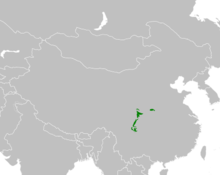 |
Size: 150–180 cm (59–71 in) long, plus 10–15 cm (4–6 in) tail 80–123 kg (176–271 lb)[4][5] Habitat: Forest[6] Diet: Eats only bamboo[6] |
VU
|
Subfamily Tremarctinae
| Common name | Scientific name and subspecies | Range | Size and ecology | IUCN status and estimated population |
|---|---|---|---|---|
| Spectacled bear
|
T. ornatus F. Cuvier, 1825 |
Andes mountains in South America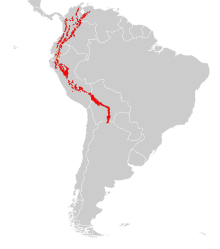 |
Size: 120–200 cm (47–79 in) long, plus 7 cm (3 in) tail 60–175 kg (132–386 lb)[7] Habitat: Shrubland, grassland, and forest[8] Diet: Primarily eats bromeliads and palm trees, as well as cattle, other mammals, and fruit[8] |
VU
|
Subfamily Ursinae
| Common name | Scientific name and subspecies | Range | Size and ecology | IUCN status and estimated population |
|---|---|---|---|---|
| Sun bear
|
H. malayanus Raffles, 1821 Two subspecies
|
Southeast Asia (current range in brown, former in black)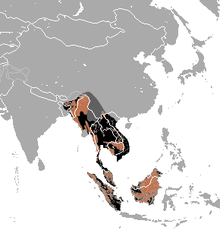 |
Size: 120–150 cm (47–59 in) long, plus 3–7 cm (1–3 in) tail 35–80 kg (77–176 lb)[9][10] Habitat: Forest and shrubland[11] Diet: Primarily eats termites, ants, beetle larvae, bee larvae, honey, and fruit[11] |
VU |
| Common name | Scientific name and subspecies | Range | Size and ecology | IUCN status and estimated population |
|---|---|---|---|---|
| Sloth bear
|
M. ursinus Shaw, 1791 Two subspecies
|
India (current range in green, former in black) |
Size: 150–180 cm (59–71 in) long, plus 7–12 cm (3–5 in) tail 54–141 kg (119–311 lb)[13] Habitat: Shrubland, grassland, forest, and savanna[14] Diet: Primarily eats termites and fruit[14] |
VU |
| Common name | Scientific name and subspecies | Range | Size and ecology | IUCN status and estimated population |
|---|---|---|---|---|
| American black bear
|
U. americanus Pallas, 1780 Sixteen subspecies
|
North America (current range in red, former in pink)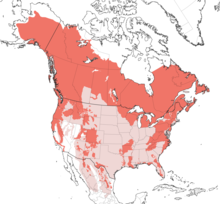 |
Size: 120–200 cm (47–79 in) long, plus 8–14 cm (3–6 in) tail 39–409 kg (86–902 lb)[16] Habitat: Forest, inland wetlands, grassland, shrubland, and desert[17] Diet: Omnivorous; eats vegetation, roots, buds, fruit, nuts, insects, fish, mammals, and carrion[17] |
LC |
| Asian black bear
|
U. thibetanus Cuvier, 1823 Seven subspecies
|
South and East Asia (current range in brown, former in black) |
Size: 120–180 cm (47–71 in) long, plus 6–11 cm (2–4 in) tail 65–150 kg (143–331 lb)[19] Habitat: Forest, inland wetlands, grassland, and shrubland[20] Diet: Eats vegetation, insects, fruit, nuts, ungulates, and livestock[20] |
VU |
| Brown bear
|
U. arctos Linnaeus, 1758 Sixteen subspecies
|
Northern North America and Europe, and northern and central Asia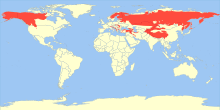 |
Size: 100–280 cm (39–110 in) long, plus 6–20 cm (2–8 in) tail 80–550 kg (176–1,213 lb)[21] Habitat: Desert, forest, inland wetlands, grassland, and shrubland[22] Diet: Omnivorous; eats grasses, herbs, roots, berries, nuts, insects, mammals, and fish[22] |
LC
|
| Polar bear
|
U. maritimus Mulgrave, 1774 |
Polar North America and Asia |
Size: 220–244 cm (87–96 in) long, plus 7–13 cm (3–5 in) tail 408–726 kg (900–1,600 lb)[23] Habitat: Marine oceanic, shrubland, forest, grassland, marine coastal/supratidal, and marine intertidal[24] Diet: Primarily eats seals, as well as walruses, beluga whales, birds, fish, vegetation and kelp[24] |
VU |
Prehistoric ursids
In addition to extant bears, a number of prehistoric species have been discovered and classified as a part of Ursidae. In addition to being placed within the three extant subfamilies, they have been categorized within the extinct subfamilies Agriotheriinae, Amphicynodontinae, Hemicyoninae, and Ursavinae, some of which are subdivided into named tribes. There is no generally accepted classification of extinct ursid species. The species listed here are based on data from the Paleobiology Database, unless otherwise cited. Where available, the approximate time period the species was extant is given in millions of years before the present (Mya), also based on data from the Paleobiology Database.[26] All listed species are extinct; where a genus or subfamily within Ursidae comprises only extinct species, it is indicated with a dagger symbol ![]()
- Subfamily Agriotheriinae

- Genus Agriotherium

- A. africanum (3.6–2.5 Mya)
- A. gregoryi
- A. inexpetans (12–5.3 Mya)
- A. insigne
- A. schneideri (14–2.5 Mya)
- A. sivalensis (5.4–3.6 Mya)
- Genus Agriotherium
- Subfamily Ailuropodinae
- Tribe Ailuropodini
- Genus Agriarctos

- Genus Ailurarctos

- A. lufengensis[27]
- Genus Ailuropoda
- A. baconi (2.6–0.012 Mya)
- A. fovealis
- A. microta (2.6–0.78 Mya)
- A. wulingshanensis (2.6–0.78 Mya)
- Genus Kretzoiarctos

- K. beatrix (12–8.7 Mya)
- Genus Agriarctos
- Tribe Indarctini

- Genus Indarctos

- I. anthracitis
- I. arctoides (9.7–8.7 Mya)
- I. atticus (8.7–5.3 Mya)
- I. nevadensis (11–4.9 Mya)
- I. oregonensis (11–4.9 Mya)
- I. salmontanus
- I. vireti
- I. zdanskyi
- Genus Miomaci

- M. pannonicum (12–9.7 Mya)
- Genus Indarctos
- Tribe Ailuropodini
- Subfamily Amphicynodontinae

- Genus Allocyon

- A. loganensis (31–20 Mya)
- Genus Amphicticeps

- A. dorog (34–28 Mya)
- A. makhchinus (34–28 Mya)
- A. shackelfordi (29–23 Mya)
- Genus Amphicynodon

- A. helveticus
- A. leptorhynchus (34–28 Mya)
- A. teilhardi (34–28 Mya)
- A. typicus (34–28 Mya)
- Genus Kolponomos

- K. clallamensis (24–20 Mya)
- K. newportensis (21–15 Mya)
- Genus Pachycynodon

- P. boriei (34–28 Mya)
- P. crassirostris (34–28 Mya)
- P. dubius (34–28 Mya)
- P. obtusus (29–23 Mya)
- Genus Parictis

- P. dakotensis (34–33 Mya)
- P. gilpini (34–33 Mya)
- P. major (38–33 Mya)
- P. montanus (38–33 Mya)
- P. parvus (38–33 Mya)
- P. personi (38–33 Mya)
- P. primaevus
- P. princeous
- Genus Allocyon
- Subfamily Hemicyoninae

- Tribe Cephalogalini

- Genus Adelpharctos

- A. ginsburgi (29–23 Mya)
- A. mirus (34–28 Mya)
- Genus Cephalogale

- C. geoffroyi
- C. meschethense (29–23 Mya)
- C. minor (34–28 Mya)
- Genus Cyonarctos

- C. dessei (29–23 Mya)
- Genus Filholictis

- F. filholi
- Genus Phoberogale

- P. depereti
- P. shareri (31–20 Mya)
- Genus Adelpharctos
- Tribe Hemicyonini

- Genus Dinocyon

- D. aurelianensis
- D. sansaniensis
- D. thenardi (17–15 Mya)
- Genus Hemicyon

- H. barbouri (14–10 Mya)
- H. goriachensis
- H. grivensis
- H. minor
- H. sansaniensis (16–12 Mya)
- H. statzlingii
- Genus Zaragocyon

- Z. daamsi (23–20 Mya)
- Genus Dinocyon
- Tribe Phoberocyonini

- Genus Phoberocyon

- P. aurelianensis (21–7.2 Mya)
- P. huerzeleri
- P. johnhenryi (21–15 Mya)
- Genus Plithocyon

- P. armagnacensis (16–11 Mya)
- P. barstowensis (16–13 Mya)
- P. ursinus (16–13 Mya)
- Genus Phoberocyon
- Tribe Cephalogalini
- Subfamily Tremarctinae
- Genus Arctodus (short-faced bear)

- A. pristinus (lesser short-faced bear) (1.8–0.012 Mya)
- A. simus (giant short-faced bear) (1.8–0.012 Mya)
- Genus Arctotherium

- A. brasiliense (0.13–0.012 Mya)
- A. brasiliensis
- A. bonariense
- A. enectum
- A. pamparum
- A. tarijense (2.6–0.78 Mya)
- A. wingei (2.6–0.012 Mya)
- Genus Plionarctos

- P. edensis (10.3–4.9 Mya)
- P. harroldorum (4.9–1.8 Mya)
- Genus Tremarctos (1.8 Mya–present)
- T. floridanus (Florida spectacled bear) (1.8–0.012 Mya)
- Genus Arctodus (short-faced bear)
- Subfamily Ursavinae

- Subfamily Ursinae
- Genus Ursus
- U. abstrusus (4.9–3.6 Mya)
- U. arctos priscus (steppe brown bear)[lower-alpha 1][28]
- U. arvernensis (3.2–2.5 Mya)
- U. deningeri (0.79–0.12 Mya) (Deninger's bear)[29]
- U. dolinensis (Gran Dolina bear)[30]
- U. dentrificius (2.6–0.12 Mya)
- U. etruscus (Etruscan bear)[31]
- U. eogroenlandicus
- U. ingressus (Gamssulzen cave bear)[32]
- U. inopinatus
- U. jenaensis
- U. labradorensis
- U. malayanus (0.13–0.012 Mya)
- U. maritimus tyrannus (tyrant polar bear)[lower-alpha 1][33]
- U. minimus (Auvergne bear) (4.2–2.5 Mya)
- U. optimus
- U. praemalayanus
- U. priscus
- U. rossicus (pleistocene small cave bear)[34]
- U. spelaeus (cave bear) (2.6–0.012 Mya)
- U. spitzbergensis
- U. vitabilis
- Genus Ursus
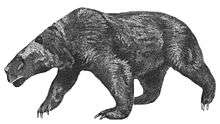 Restoration of Kolponomos newportensis
Restoration of Kolponomos newportensis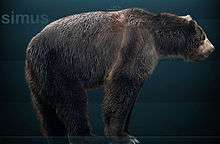 Restoration of Arctodus simus
Restoration of Arctodus simus Restoration of Arctotherium bonariense
Restoration of Arctotherium bonariense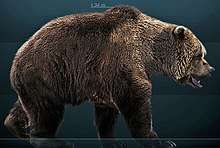 Restoration of Ursus spelaeus (cave bear)
Restoration of Ursus spelaeus (cave bear) Prehistoric art of Ursus spelaeus (cave bear)
Prehistoric art of Ursus spelaeus (cave bear)
Notes
- Extinct prehistoric subspecies of an extant species
References
- Findeizen, Nikolai (2008). History of Music in Russia from Antiquity to 1800, Vol. 1: From Antiquity to the Beginning of the Eighteenth Century. Indiana University Press. p. 201. ISBN 978-0-253-02637-8.
- Calvignac, S.; Hughes, S.; Tougard, C.; Michaux, J.; Thevenot, M.; Philippe, M.; Hamdine, W.; Hanni, C. (2008). "Ancient DNA evidence for the loss of a highly divergent brown bear clade during historical times". Molecular Ecology. 17 (8): 1962–1970. doi:10.1111/j.1365-294x.2008.03631.x. PMID 18363668.
- Lan, T.; Gill, S.; Bellemain, E.; Bischof, R.; Zawaz, M. A.; Lindqvist, C. (2017). "Evolutionary history of enigmatic bears in the Tibetan Plateau–Himalaya region and the identity of the yeti". Proceedings of the Royal Society B: Biological Sciences. 284 (1868): 20171804. doi:10.1098/rspb.2017.1804. PMC 5740279. PMID 29187630.
- Bies, LeeAnn (2002). "Ailuropoda melanoleuca". Animal Diversity Web. University of Michigan. Retrieved March 24, 2020.
- "Physical Description". Knowledge Hub. World Wide Fund for Nature. Retrieved March 24, 2020.
- Swaisgood, R.; Wang, D.; Wei, F. (2016). "Ailuropoda melanoleuca (errata version published in 2017)". IUCN Red List of Threatened Species. IUCN. 2016: e.T712A121745669.
- "Spectacled bear (Tremarctos ornatus)". ARKive. Wildscreen. Archived from the original on June 14, 2017. Retrieved March 25, 2020.
- Velez-Liendo, X.; García-Rangel, S. (2017). "Tremarctos ornatus (errata version published in 2018)". IUCN Red List of Threatened Species. 2017: e.T22066A45034047. doi:10.2305/IUCN.UK.2017-3.RLTS.T22066A45034047.en.
- "Malayan sun bear (Helarctos malayanus)". ARKive. Wildscreen. Archived from the original on December 21, 2014. Retrieved March 26, 2020.
- Brown, Gary (February 1996). Great Bear Almanac. The Lyons Press. p. 340. ISBN 978-1-55821-474-3.
- Scotson, L.; Fredriksson, G.; Augeri, D.; Cheah, C.; Ngoprasert, D.; Wai-Ming, W. (2017). "Helarctos malayanus (errata version published in 2018)". IUCN Red List of Threatened Species. 2017: e.T9760A45033547. doi:10.2305/IUCN.UK.2017-3.RLTS.T9760A45033547.en.
- Dickson, B. (November 5, 2013). Endangered Species Threatened Convention. Routledge. p. 82. ISBN 978-1-134-19434-6.
- "Sloth Bear". The Photo Ark. National Geographic. Retrieved March 24, 2020.
- Dharaiya, N.; Bargali, H. S.; Sharp, T. (2016). "Melursus ursinus". IUCN Red List of Threatened Species. 2016: e.T13143A45033815. doi:10.2305/IUCN.UK.2016-3.RLTS.T13143A45033815.en.
- Ramesh, T.; Kalle, R.; Sankar, K.; Qureshi, Q. (2012). "Factors affecting habitat patch use by sloth bears in Mudumalai Tiger Reserve, Western Ghats, India". Ursus. 23 (1): 78–85. doi:10.2192/URSUS-D-11-00006.1. JSTOR 41818973.
- Dewey, Tanya; Kronk, Christine (2007). "Ursus americanus". Animal Diversity Web. University of Michigan. Retrieved March 24, 2020.
- Garshelis, D. L.; Scheick, B. K.; Doan-Crider, D. L.; Beecham, J. J.; Obbard, M. E. (2016). "Ursus americanus (errata version published in 2017)". IUCN Red List of Threatened Species. 2016: e.T41687A45034604. doi:10.2305/IUCN.UK.2016-3.RLTS.T41687A45034604.en.
- "Black Bear Study Finds Growing Populations, But Combating Illegal Trade Remains a Challenge". WWF News and Reports. World Wide Fund for Nature. April 30, 2002. Retrieved February 29, 2020.
- Goodness, Tracie (2004). "Ursus thibetanus". Animal Diversity Web. University of Michigan. Retrieved March 24, 2020.
- Garshelis, D.; Steinmetz, R. (2016). "Ursus thibetanus (errata version published in 2017)". IUCN Red List of Threatened Species. 2016: e.T22824A45034242. doi:10.2305/IUCN.UK.2016-3.RLTS.T22824A45034242.en.
- "Brown Bear (Ursus arctos) Fact Sheet: Physical Characteristics". San Diego Zoo Global Library. San Diego Zoo. October 15, 2019. Retrieved March 26, 2020.
- McLellan, B. N.; Proctor, M. F.; Huber, D.; Michel, S. (2017). "Ursus arctos (amended version of 2017 assessment)". IUCN Red List of Threatened Species. 2017: e.T41688A121229971. doi:10.2305/IUCN.UK.2017-3.RLTS.T41688A121229971.en.
- "Polar Bear". The Photo Ark. National Geographic. September 10, 2010. Retrieved March 24, 2020.
- Wiig, Ø.; Amstrup, S.; Atwood, T.; Laidre, K.; Lunn, N.; Obbard, M.; Regehr, E.; Thiemann, G. (2015). "Ursus maritimus". IUCN Red List of Threatened Species. 2015: e.T22823A14871490. doi:10.2305/IUCN.UK.2015-4.RLTS.T22823A14871490.en.
- Hamilton, S. G.; Derocher, A. E. (2019). "Assessment of global polar bear abundance and vulnerability". Animal Conservation. 22 (1): 83–95. doi:10.1111/acv.12439.
- "Fossilworks: Ursidae". Paleobiology Database. University of Wisconsin–Madison. Retrieved February 27, 2020.
- Qiu, Z.; Qi, G. (1989). "Yúnnán lù fēng wǎn zhōng xīn shì de dà xióngmāo zǔxiān huàshí" 云南禄丰晚中新世的大熊猫祖先化石 [Ailuropod Found From the Late Miocene Deposits in Lufeng, Yunnan] (PDF). Vertebrata PalAsiatica. 27 (3): 153–169.
- Sabol, M. (2001). "Fossil Brown Bears of Slovakia (Los osos pardos fósiles de Eslovaquia)" (PDF). Cadernos do Laboratorio Xeolóxico de Laxe. Bratislava. 26: 311–316. ISSN 0213-4497.
- García, N.; Santos, E.; Arsuaga, J. L.; Carretero, J. M. (December 2007). "Endocranial morphology of the Ursus deningeri von Reichenau 1904 from the Sima de los huesos (Sierra de Atapuerca) middle Pleistocene site". Journal of Vertebrate Paleontology. 27 (4): 1007–1017. doi:10.1671/0272-4634(2007)27[1007:EMOTUD]2.0.CO;2.
- Garcı́a, N.; Arsuaga, J. L. (June 15, 2001). "Ursus dolinensis4: a new species of Early Pleistocene ursid from Trinchera Dolina, Atapuerca (Spain)". Comptes rendus de l'Académie des Sciences, Série IIA. 332 (11): 717–725. doi:10.1016/S1251-8050(01)01588-9.
- Pérez-Hidalgo, T.; José, T. (1992). "The European descendants of Ursus etruscus C. Cuvier (Mammalia, Carnivora, Ursidae)". Boletín del Instituto Geológico y Minero de España. 103 (4): 632–642.
- Rabeder, G.; Hofreiter, M.; Nagel, D.; Withalm, G. (January 2004). "New taxa of alpine cave bears (Ursidae, Carnivora)". Cahiers scientifiques-Muséum d'histoire naturelle de Lyon. 2 (2): 49–67.
- Kurtén, B. (1964). "The evolution of the polar bear, Ursus maritimus Phipps". Acta Zoologica Fennica. 108: 1–26. hdl:10138/37762.
- Baryshnikov, G.; Foronova, I. (January 2001). "Pleistocene small cave bear (Ursus rossicus) from the South Siberia, Russia" (PDF). Cadernos do Laboratorio Xeolóxico de Laxe. 26: 373–398. ISSN 0213-4497.

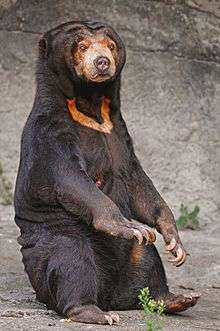


.jpg)